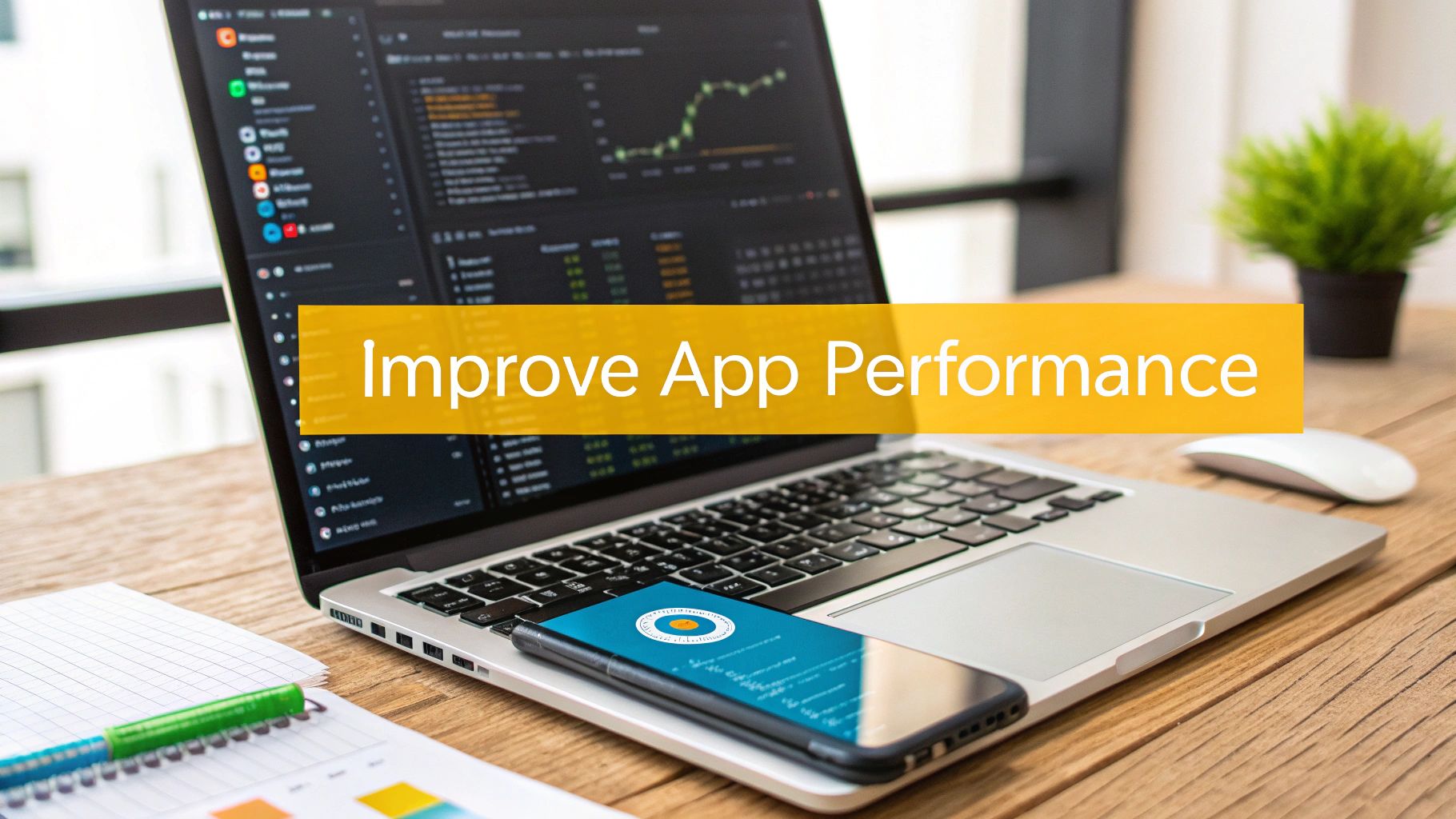A Developer's Guide to Improve App Performance

When we talk about truly improving app performance, it's not just about tweaking code. It's about focusing on three fundamental areas that directly shape how users feel about your application: boosting stability, increasing speed, and optimizing resource efficiency. Getting these right isn't just a technical win; it's the foundation for creating an experience that keeps people coming back.
Why App Performance Is Your Most Critical Metric

In a market overflowing with options, your app's performance is often the first—and sometimes the last—impression you'll make. This goes far beyond just trying to dodge negative reviews. It's about building a dependable tool that users can count on. A slow startup, a frozen screen, or a sudden crash can shatter that trust in an instant, sending users straight to your competitors.
The link between a high-performing app and business success is crystal clear. A snappy, responsive experience encourages people to stick around longer and use the app more often. This directly translates to better user loyalty and, ultimately, higher lifetime value. On the flip side, poor performance doesn't just fail to impress; it actively pushes your users away.
The High Cost of Poor Performance
Keeping users engaged is one of the toughest challenges in the app world. The numbers paint a pretty stark picture: a staggering 77% of an app's daily active users are gone within just three days of installation. What's driving them away? A major factor is instability. In fact, data shows 60% of users will ditch an app after it crashes just a few times. You can explore more of these mobile app optimization findings to see the full impact.
This means your window to demonstrate value is incredibly narrow. Every single performance hiccup erodes your user base, which is why making speed and stability a top priority from day one is non-negotiable.
A user who experiences a crash on their first use is highly unlikely to give your app a second chance. Performance isn't a feature—it's the bedrock upon which all other features are built.
To bring a clear focus to your optimization efforts, it helps to organize your work around the three core pillars of performance. This framework ensures you're tackling the issues that have the most direct and meaningful impact on your users.
Let's break down these pillars and what they mean for the end-user.
Core Pillars of App Performance Improvement
| Performance Pillar | Primary Goal | Impact on User Experience |
|---|---|---|
| Stability | Minimize crashes and errors | Builds trust and reliability; prevents the frustration that leads to uninstalls. |
| Speed | Reduce startup time and UI lag | Creates a fluid, professional feel that keeps users engaged and happy. |
| Efficiency | Optimize memory, CPU, and battery use | Ensures smooth operation on all devices and preserves battery life, a key factor in user satisfaction. |
By addressing these three areas—stability, speed, and efficiency—you're not just fixing technical problems. You're systematically improving the entire user experience, creating a more reliable, enjoyable, and valuable application.
Digging into Code-Level Optimizations for a Faster App

While big-picture strategies are crucial, true application performance is won or lost in the code itself. Clean, efficient logic is the engine that drives a snappy, responsive user experience. It's time to roll up our sleeves and refine the very building blocks of your app.
A fantastic, and often overlooked, place to start is with your data structures. The choice between an Array and a Set might seem trivial, but the performance implications are huge. For instance, if you're constantly checking if an item exists within a massive collection, a Set provides almost instantaneous lookups. Trying to do the same thing with an Array can create a serious bottleneck as the list grows.
Choosing the Right Tools and Techniques
This mindset of picking the right tool for the job should permeate your entire codebase. Are you running the same complex calculation repeatedly within a single function? A simple fix is to cache that result in a variable, saving precious CPU cycles and making everything feel just a little bit smoother.
Loops are another classic performance trap. A poorly written loop, especially one doing heavy lifting, can make your UI stutter or freeze entirely. I've seen it happen countless times.
- Keep complex logic out of your loops. If you can, do your calculations or object allocations before or after the loop runs.
- Use the most efficient iteration methods available. Your platform's native iterators are often faster than a generic
for-eachloop. - Break up tasks that take too long. For really intensive loops, think about processing the data in smaller batches so you don't block the main thread.
The real goal here is to develop an instinct for performance. You want to get to a point where you’re automatically questioning the cost of every line of code. This proactive habit is what separates good apps from great ones that feel reliable and fast from the very first launch.
Platform-Specific Optimizations Make a Difference
To truly improve app performance, you can't ignore the unique quirks and features of each platform. An optimization that works wonders on iOS might not be the best approach for an Android app.
For example, on iOS, Swift's value types (like a struct) can often outperform reference types (a class). This is because they sidestep the overhead that comes with reference counting. Using structs for simpler data models can give you a noticeable speed boost.
Meanwhile, for Android developers working in Kotlin, coroutines are a game-changer. They are essential for managing background tasks without locking up the main thread, ensuring your UI stays perfectly responsive while the app is fetching data or running heavy calculations. For more insights like this, check out our guide on mobile app development tips.
Let's make this real. Imagine your app needs to show a list of user profiles, and each profile picture needs some processing.
An inefficient way to do this would be to process everything right in the loop, one after another, on the main thread.
A much better, optimized approach is to push that heavy work to a background thread. You process the images there, and then, only when an image is ready, you hop back to the main thread just to update the UI.
This asynchronous pattern is the key to preventing a frozen UI and creating a vastly superior user experience. By consciously applying these kinds of code-level strategies, you're laying the groundwork for a truly high-performing application.
Tackling Memory Management and Resource Usage

There's no quicker way to frustrate a user than with an app that devours their device's memory and battery. While we often focus on features, efficient resource management is a make-or-break factor to improve app performance. A poorly managed app isn't just slow; it can be shut down by the operating system without warning, creating a terrible user experience.
This isn't a one-size-fits-all problem, either. The resource battle plays out differently across platforms. Data reveals Android logs a low-memory warning rate of 12.94%, which is more than double the 5.49% seen on iOS. In plain English, that means an Android app is far more likely to be on the verge of being force-closed by the OS. Understanding these platform-specific quirks is the first step to building a resilient app.
Hunting Down Memory Leaks
Among the most damaging performance issues is the dreaded memory leak. This happens when your app claims a chunk of memory for a task but never gives it back once the task is done. Bit by bit, these orphaned memory blocks pile up, eating away at available RAM until your app becomes sluggish or crashes entirely.
You have to be proactive about this. Actively hunting for leaks should be a standard part of your development and testing workflow. Luckily, both major platforms give you the tools you need to play detective.
- For iOS: The Instruments tool within Xcode is essential. Use its Allocations and Leaks instruments to get a granular view of your app's memory footprint and to automatically flag leaked objects.
- For Android: The Android Studio Memory Profiler is your go-to. It gives you a live graph of memory consumption, and you can capture a "heap dump" at any point to inspect which objects are lingering when they shouldn’t be.
Using these tools isn't just about bug-squashing after the fact. It’s a fundamental part of a solid testing process. We dive deeper into this philosophy in our guide on quality assurance in software development.
Memory leaks are silent assassins. They rarely cause an immediate, obvious crash. Instead, they slowly degrade performance over time, creating a laggy experience that users will definitely feel, even if they can't explain why.
Smart Resource Handling and Audits
Beyond specific leaks, your app's general consumption of resources directly impacts its performance. Every image, animation, and network call adds to the load on the CPU and memory.
Images are a classic offender. Loading a beautiful, high-resolution photo without optimizing it first can easily choke a lower-end device. This is where a smart caching strategy becomes non-negotiable. By caching properly sized and decoded images, you save the app from having to do the same intensive work over and over, resulting in buttery-smooth scrolling.
Finally, don't forget to look at your third-party dependencies. SDKs and libraries can be lifesavers, but some are notoriously bloated resource hogs. Make it a habit to periodically audit their impact. If a particular SDK is spiking CPU or memory usage, it might be time to search for a leaner alternative. Staying vigilant keeps your app swift and responsive.
Optimizing Network Requests for a Faster Experience

In our connected world, the way your app talks to servers can make or break the user experience. It's often the biggest performance bottleneck you'll face. Every single data fetch, API call, and content load is a potential point of friction.
Let's be honest, those frustrating loading screens are almost always caused by slow or excessive network requests. It makes the app feel clunky, sometimes even broken.
If you want to improve app performance, you have to get a handle on these requests. The goal is to make your app feel snappy and responsive, even when the user is on a spotty Wi-Fi connection. This all comes down to being smarter about how and when you ask for data.
Shrink Data Payloads and Reduce Server Round Trips
The first rule I learned in network optimization is beautifully simple: just send less stuff. Smaller data payloads mean faster transfer times, which is a lifesaver on mobile networks where bandwidth is often a precious commodity. Compressing data before it ever leaves the server is a non-negotiable first step.
A powerful tactic here is to adopt modern data formats. For instance, I've seen teams get huge wins by switching from verbose JSON to a binary format like Google's Protocol Buffers (Protobuf). This can drastically shrink API response sizes, meaning less data to push over the wire and less work for the device to parse on the other end.
At the same time, you need to cut down the number of trips the app makes to the server. Every back-and-forth adds latency.
- Bundle Your API Calls: Instead of making three separate calls to get user details, their posts, and their comments, design a single, efficient endpoint that returns all that data in one neat package.
- Prefetch Critical Data: Try to think one step ahead of your user. When they open a list of articles, you can quietly start pre-fetching the full content for the top few items in the background.
This proactive approach makes the application feel incredibly fast because the data is often already there before the user even taps the screen.
Your app's perceived speed is often more about how you handle the waiting than the actual network speed itself. A user will forgive a short, well-managed loading state but will quickly abandon an app that just freezes up while fetching data.
Build Smart Caching and Handle Offline States Gracefully
Beyond making requests more efficient, the next level is to avoid making them in the first place. An intelligent caching system is your best friend here. By storing frequently accessed data directly on the device, you eliminate the need to go back to the server for the same information over and over again.
This doesn't just make the app faster; it also creates a much more resilient offline experience. If a user walks into a tunnel and loses their connection, a well-cached app can keep on trucking. It can display previously loaded content instead of throwing up a useless error message.
Handling poor connectivity with grace is just as important. Your app should never become unresponsive when the network is slow or disappears entirely. You need to implement clear timeout policies for your requests and give the user immediate feedback—something as simple as a "could not connect" message lets them know what's happening so they aren't left guessing.
By combining smaller payloads, fewer requests, and smart caching, you’re not just optimizing code; you’re building a faster, more reliable, and far less frustrating experience for your users.
Set Up a Proactive Monitoring Strategy
If you're only finding out about performance problems from angry one-star reviews, you're already behind. The single biggest shift you can make for consistent performance gains is moving from a reactive "fix-it-when-it-breaks" approach to a proactive monitoring strategy. It’s about creating a continuous feedback loop where real-world data drives your development choices.
This isn't about just waiting for the fire alarm to go off. It’s about actively hunting for performance bottlenecks, sniffing out stability issues, and smoothing over user experience friction before most of your users even notice. A solid monitoring setup gives you a window into how your app actually behaves on thousands of different devices, under all sorts of real-world network conditions.
Figure Out What to Measure
First things first: you have to define what "good performance" even means for your specific app. This isn't a one-size-fits-all metric. It requires tracking a healthy mix of technical health stats and user-centric Key Performance Indicators (KPIs).
For example, you'll want to watch everything from user growth and retention rates to crash frequency and daily active users (DAU/MAU). But don't forget the money. Financial indicators like Average Revenue Per User (ARPU) directly show you how performance (or lack thereof) hits your bottom line. To get a deeper understanding, you can explore the full range of mobile app performance metrics with UXCam and see what a comprehensive dashboard looks like.
This dashboard shows how different metrics can be tracked together for a complete picture of your app's health.
When you see a dip in session length right after your crash rate spikes, you’ve found a direct link between a technical bug and its impact on user engagement. That's the kind of insight you're after.
To get started, every team should have a few essential tools in their monitoring stack:
- Crash Reporting Tools: These are absolutely non-negotiable. Tools like Sentry or Firebase Crashlytics instantly ping you when a crash happens, serving up detailed stack traces so you can find the exact line of faulty code.
- Real User Monitoring (RUM) Tools: RUM goes beyond just crashes. It measures what your users are actually experiencing—things like app startup time, how quickly screens transition, and network request delays. This gives you a clear picture of perceived speed.
- Performance Analytics Platforms: These are the tools that connect the dots. They help you answer the really important questions, like, "Do users who suffer from slow load times churn more often?"
A good monitoring strategy turns performance from a vague, subjective complaint into a concrete set of numbers. It gives your entire team a shared language and a clear target to hit, replacing guesswork with data.
To effectively monitor your app, it's crucial to track a combination of metrics that cover both the technical underpinnings and the end-user experience. Below is a table outlining the essential KPIs that development teams should keep a close eye on.
Essential App Performance KPIs to Monitor
| Metric Category | KPI | What It Measures |
|---|---|---|
| Technical Health | Crash Rate | The percentage of app sessions that end in a crash. A critical indicator of stability. |
| Technical Health | API Latency | The time it takes for your app to get a response from a server after making a request. |
| Technical Health | App Start Time | The duration from when a user taps the app icon to when it becomes interactive. |
| User Engagement | Session Length | The average amount of time a user spends in the app during a single session. |
| User Engagement | DAU/MAU | Daily Active Users vs. Monthly Active Users. Measures user stickiness and retention. |
| User Engagement | Screen Load Time | The time it takes for individual screens or features within the app to become usable. |
Tracking these KPIs provides a balanced view, helping you prioritize fixes that will have the most significant impact on both app stability and user satisfaction.
Build a Data-Driven Feedback Loop
Once your monitoring tools are collecting data, the real work begins. The goal is to plug these performance insights directly into your development workflow. This fits perfectly with the iterative nature of agile development, where continuous feedback is king. If you're new to the concept, it's worth reviewing some agile software development best practices.
Here's how it should work in practice: when a monitoring tool flags a new performance issue, it shouldn't be thrown onto a massive, forgotten backlog. Treat it like any other bug or feature request. It needs to be triaged, prioritized, and assigned to a developer. This simple process keeps performance at the forefront and ensures you’re systematically squashing problems before they snowball and affect your entire user base.
Answering the Tough Questions About App Performance
Even with the best strategies in place, the day-to-day reality of building and maintaining an app brings up some tough questions. It's one thing to know the theory, but another to navigate the trade-offs that pop up in every sprint.
Let's break down some of the most common dilemmas I've seen teams wrestle with when trying to boost their app's performance.
We're a Startup. Which Metrics Actually Matter Right Now?
When you're a startup, you're running lean. Your time, money, and energy are finite, so you can't afford to get lost chasing every metric under the sun. You need to focus on what will kill your app fastest if you ignore it.
Start with the data that directly reflects user pain and predicts whether they'll stick around.
Your first performance dashboard should be simple and focused. I'd recommend tracking these three things above all else:
- Crash Rate: This is your top priority. Nothing sends a user packing faster than an app that constantly crashes. You should be aiming for a crash-free user rate of over 99.5%.
- App Start Time: First impressions are everything. A slow cold start—that first launch after an install—immediately makes your app feel sluggish and poorly built.
- User Retention Rate: This is your ultimate source of truth. Are people coming back? If they are, you're on the right track. If your retention is dropping, performance issues are often a major, silent contributor.
Don't get distracted by vanity metrics. Nail these three first. Once you've stabilized crashes, improved startup speed, and have a healthy retention rate, you can expand your focus to more granular details like API latency or specific screen load times.
How Do We Balance Shipping New Features with Fixing Performance?
Ah, the classic tug-of-war. Your product manager is pushing for shiny new features to attract and retain users. Meanwhile, your engineers are warning that technical debt is accumulating and the app is getting slower with every release. How do you move forward without letting one side completely dominate the other?
The answer isn't to put a freeze on new features. That's a great way to fall behind the competition. Instead, you need to weave performance work into the very fabric of your development process.
I've had great success with a "one for them, one for us" approach. For every major feature you ship, you also commit to tackling a piece of performance-related tech debt in the same development cycle. Maybe that means refactoring a notoriously slow bit of code, optimizing how you load images, or finally hunting down that pesky memory leak.
This creates a sustainable rhythm. It stops performance from becoming this huge, intimidating monster of a project that you only tackle once a year. It becomes a continuous, manageable habit that's just part of how your team operates.
Help! Our App Suddenly Got Slow. What Do We Do First?
That sinking feeling when users start complaining that the app feels sluggish "all of a sudden" is something most developers have experienced. When this happens, stay calm and remember: the culprit is almost always something that changed recently.
Here’s your immediate game plan:
Jump into Your Monitoring Tools: Your crash reporting and Application Performance Monitoring (APM) dashboards are your best friends here. Look for any immediate red flags. Did a key API suddenly get slower? Are you seeing a spike in low-memory warnings? Is a new type of crash popping up since the last update?
Audit Recent Changes: Put on your detective hat and examine the commits that went into the last release. Pay close attention to any new additions. A new third-party SDK, a complex database query, or a feature that loads a ton of assets are common offenders.
Isolate the Cause: This is where feature flags are a lifesaver. If you suspect a new feature is the problem, try disabling it for a segment of users or in your testing environment. This lets you confirm the source of the slowdown without having to roll back the entire release and disrupt everyone.
Acting fast with a methodical approach like this helps you pinpoint the root cause, push out a targeted hotfix, and get back to giving your users the smooth experience they expect.